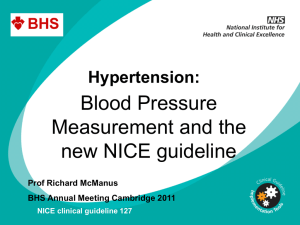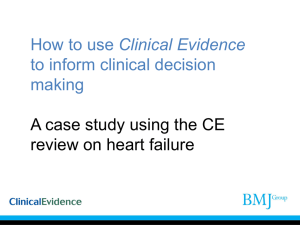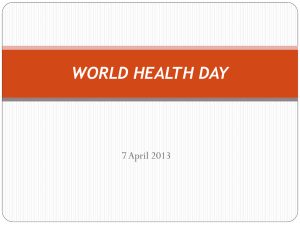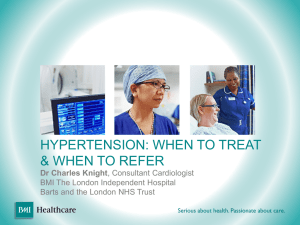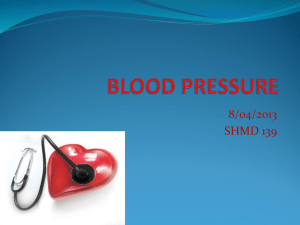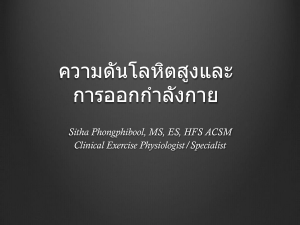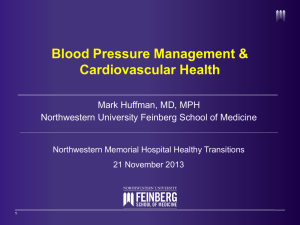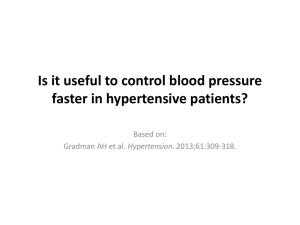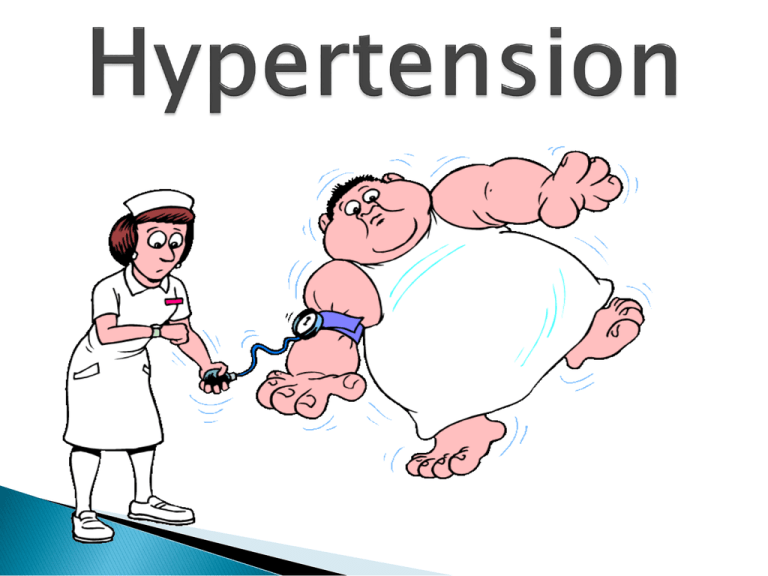
After this talk you should;
Know how to measure blood pressure accurately and
consistently
Know when to start and how to monitor drug treatment
Feel confident about when to consider secondary
hypertension
Know when to refer patients for further investigation and
management.
The world health organisation (WHO) and the international
hypertension society defines hypertension as having a
systolic blood pressure above 140 mm Hg, or a diastolic
blood pressure above 90 mm Hg, or both, on at least 3
separate occasions.
Hypertension remains underdiagnosed, undertreated and poorly controlled in the UK.
Prevalence in over 35s
- 32% of Men
- 27% of women
This increases with age
- 33% of men and 25% of women aged 45-54 years have hypertension.
- 73% of men and 64% of women aged ≥75 years have hypertension.
Screening for hypertension
All adults should have their blood pressure measured, at least every five years up to
the age of 80, and at least annually thereafter.
Risk factor for leading causes of deaths in the Western world
Each 2 mmHg rise in systolic blood pressure associated with;
- 7% increased risk of mortality from IHD
- 10% increased risk of mortality from stroke
vascular and renal damage caused by untreated hypertension can culminate in a
treatment-resistant state.
Data from therapeutic trials of antihypertensive drugs consistently show reductions
in cardiovascular events and total mortality without adversely affecting quality of
life.
• Usually asymptomatic and detected opportunstically
• Alternatively, patients may present with complications
• In the UK, the Quality and Outcomes Framework sets goals linked to
GPs’ remuneration encourages GPs to measure BP in asymptomatic
patients
• Increased availability of home BP monitoring / blood pressure
measurement in pharmacies
• Measure BP in both arms.
• If difference between arms >20 mmHg repeat
• If difference between arms remains >20 mmHg on the 2nd measurement,
measure subsequent BPs in arm with higher reading
• If BP measured is 140/90 mmHg or higher:
• Take second measurement
• If second substantially different take a third
• Record lower of the two measurements
• Either automated machine or manual method
• If pule is irregular - always use manual
• Record to the nearest 2 mmHg
•
If the blood pressure is 140/90 mmHg or higher, offer ABPM to confirm
the diagnosis of hypertension
• If a person is unable to tolerate ABPM, HBPM is a suitable alternative to
confirm the diagnosis of hypertension.
• While waiting to confirm diagnosis, investigate target organ damage and
assess cardiovascular risk
• Those with high normal values (130-139/85-89 mm Hg) should be
checked annually.
Ambulatory blood pressure monitoring
Ensure two measurements /hour taken during the person’s usual waking hours
Use the average value of at least 14 measurements to confirm the diagnosis.
Home blood pressure monitoring
Ensure that:
• Two consecutive measurements are taken, at least 1 minute apart and with the
person seated
• BP is recorded twice daily
• BP recording continues for at least 4 days, ideally for 7 days.
Discard the measurements taken on the first day and use the average value of all
the remaining measurements to confirm the diagnosis.
Stage 1 hypertension
• Clinic blood pressure is 140/90 mmHg or higher and subsequent ABP daytime
average or HBPM average blood pressure is 135/85 mmHg or higher.
Stage 2 hypertension
• Clinic blood pressure is 160/100 mmHg or higher and subsequent ABPM daytime
average or HBPM average blood pressure is 150/95 mmHg or higher.
Severe hypertension
• Clinic systolic blood pressure is 180 mmHg or higher or clinic diastolic blood
pressure is 110 mmHg or higher.
Risk factors for cardiovascular disease :
•
Age
•
Sex
•
Socioeconomic group
•
Smoking habits throughout the patient’s lifetime
•
Family history of cardiovascular disease
•
Personal history of diabetes, kidney disease, or elevated cholesterol.
Symptoms suggesting cardiac complications of hypertension
(ischaemia, infarction, or congestive cardiac failure) :
•
Chest pain
•
Breathlessness
•
Ankle swelling
•
Palpitations.
You should also check for clinical features that may suggest secondary
hypertension.
Look for signs of hypertensive complications:
•
Fundoscopy
•
Observation of neck veins.
•
Assessment of the apex beat
•
Auscultation of the heart for murmurs
•
Auscultation of the lungs
•
Palpation of the radial, popliteal, and foot pulses.
•
Assessment of the ankles and sacrum
•
Auscultation of the carotid arteries
Look for complications or possible secondary hypertension:
•
Urinalysis with dipstick testing
•
A resting 12-lead electrocardiogram (ECG)
•
Urea and electrolytes
•
Serum glucose (ideally fasting)
•
Serum lipid profile
•
Thyroid function tests
•
Glomerular filtration rate.
Secondary hypertension
Around 5% of people with hypertension - high blood pressure is due to an
underlying (secondary) disease.
Causes include:
Chronic renal disease
Cushing’s syndrome
Primary aldosteronism
Thyrotoxicosis
Phaeochromocytoma.
Common clinical features include:
Age younger than 30
Sudden worsening of hypertension
Poor response to treatment.
NICE recommends;
●
Using a formal estimation of cardiovascular risk to discuss
prognosis and healthcare options with people with
hypertension, both for raised blood pressure and other
modifiable risk factors.
• Aged under 80 years with stage 1 hypertension who have one or more of the
following:
•
target organ damage
•
established cardiovascular disease
•
renal disease
•
diabetes
•
a 10-year cardiovascular risk equivalent to 20% or greater.
• Any age with stage 2 hypertension
• Aged under 40 years with stage 1 hypertension and no evidence of target organ
damage, cardiovascular disease, renal disease or diabetes, consider seeking
specialist evaluation.
●
●
●
●
●
Malignant (accelerated) hypertension - severe hypertension (eg systolic >200
mm Hg, diastolic >130 mm Hg), encephalopathy or nephropathy, papilloedema
and/or angiopathic haemolytic anaemia.
Accelerated hypertension needs urgent (same day) assessment and treatment.
Suspected phaeochromocytoma - Consider this diagnosis if there is labile or
postural hypotension, headache, palpitations, pallor and profuse sweating - refer
for urgent (same day) assessment.
Hypertensive crisis - a systolic blood pressure (SBP) ≥180 mm Hg or a diastolic
blood pressure (DBP) ≥120 mm Hg . Treatment should safely reduce BP.
Immediate reduction in BP is required only in patients with acute end-organ
damage
●
●
●
●
●
If possible, offer drugs taken only once a day
Prescribe non-proprietary drugs if these are appropriate and
minimise cost
Offer people with isolated systolic hypertension the same
treatment as people with both raised systolic and diastolic blood
pressure
Offer people aged over 80 years the same antihypertensive drug
treatment as people aged 55–80 years, taking into account any
comorbidities.
Do not combine an ACE inhibitor with an angiotensin II receptor
blocker (ARB).
• Ask people about their diet and exercise patterns, and promote lifestyle changes 30 mins brisk exercise a day, (DASH)
• Weight loss
• Alcohol consumption - limit intake to 21/14 units a week
• Discourage excessive consumption of coffee and other caffeine-rich products
• Encourage people to keep their salt intake low
• Offer people who smoke advice and help to stop smoking
• It is not recommended that primary care teams provide relaxation therapies
routinely
•
Do not offer calcium, magnesium or potassium supplements as a method for
reducing blood pressure
•
under 55 years – ACE inhibitor or a low-cost ARB.
•
Over 55 or Afro-Carribean of any age - Calcium channel blocker
•
If a CCB is not suitable, for example because of oedema or intolerance, or if there
is evidence of heart failure or a high risk of heart failure, offer a thiazide-like
diuretic.
•
If diuretic treatment is to be initiated or changed, offer a thiazidelike diuretic,
such as chlortalidone or indapamidE in preference to a conventional thiazide
diuretic such as bendroflumethiazide or hydrochlorothiazide.
•
For people who are already having treatment with bendroflumethiazide or
hydrochlorothiazide and whose blood pressure is stable and well controlled,
continue treatment with the bendroflumethiazide or hydrochlorothiazide.
Step 2 treatment
- If blood pressure is not controlled by step 1 treatment
Offer with a CCB in combination with either an ACE inhibitor or ARB
If a CCB is not suitable , offer a thiazide-like diuretic (CCB intolerance, or if there is
evidence of heart failure or a high risk of heart failure).
For black people of African or Caribbean family origin:
Consider an ARB in preference to an ACE inhibitor, in combination with a CCB
Step 3 treatment
Before considering step 3 treatment
review medication to ensure step 2 treatment is at optimal or best tolerated doses
Combination of three drugs:
ACE inhibitor or angiotensin II receptor blocker,
Calcium-channel blocker
And Thiazide-like diuretic should be used
Step 4 treatment
If BP remains higher than 140/90 mmHg after treatment with the optimal or best
tolerated doses of an ACE inhibitor or an ARB plus a CCB plus a diuretic as resistant
hypertension, and consider adding a fourth antihypertensive drug & Or ( Alpha blocker
or B-Blocker and seek expert advice )
Spironolactone (25 mg Od) if Potassium level is 4.5 mmol/l or lower. (Caution in pts
with reduced GFR increased risk of hyperkalemia.)
Consider higher-dose thiazide-like diuretic treatment if the blood potassium level is
higher than 4.5mmol/l. (monitor Na , K, Renal function within one month & repeat as
required.)
If BP uncontrolled with optimal or maximal tolerated doses of four drugs, Seek expert
Advice
Clinical Blood pressure:
• People aged under 80 years: lower than 140/90 mm Hg
• People aged over 80 years: lower than 150/90 mm Hg
Daytime average APBM OR average HBPM blood pressure during persona's usual
waking hours.
• People aged under 80 years: lower than 135/85 mm Hg
• People aged over 80 years: lower than 145/85 mm Hg
lower BP targets are recommended for diabetics;
• Type 1 diabetes: <135/85mmHg, or <130/80mmHg with nephropathy
• Type 2 diabetes: <140/80mmHg, or <135/75mmHg if microalbuminuria or
proteinuria is present
Urgent treatment needed: accelerated hypertension, severe hypertension
(>220/>120 mm Hg) or impending complications (eg TIA, LVF).
Possible underlying cause: low K+, Na+ elevated (possible Conn's syndrome);
elevated creatinine, proteinuria or haematuria; sudden onset or rapidly
worsening or resistant hypertension (ie needs >3 drugs); young age: patient
aged <20 years, or <30 years needing treatment.
Therapeutic problems: multiple drug intolerance or contra-indications,
persistent noncompliance or treatment refusal (the reluctant hypertensive).
Special situations: hypertension in pregnancy, unusual blood pressure (BP)
variability.
Please collect a question sheet and get into
groups of 3
Question 1
A 65 year old woman who is newly diagnosed with hypertension attends your
morning surgery for initial assessment. Which of the following is NOT
recommended as part of the initial assessment of a patient with hypertension?
A - Measurement of weight, height, and waist circumference
B - Resting 12-lead ECG
C - Dipstick urinalysis
D - Full blood count
E - Urea and electrolytes
Question 1 – Answer
D – Full Blood count
Question 2
What are current recommendations for choosing sphygmomanometer cuffs?
A - The size of the cuff doesn’t matter: you should use the cuff that appears to be in the
best condition
B - You should chose the cuff based on the patient’s arm circumference: the rubber
bladder within the cuff should have a length of 80% of the arm circumference and a
width of 40% of the arm circumference
C- You should chose the cuff based on the patient’s arm circumference: the rubber
bladder within the cuff should have a length of 40% of the arm circumference and a
width of 20% of the arm circumference
D - You should chose the cuff based on the patient’s arm circumference: the rubber
bladder within the cuff should have a length of 120% of the arm circumference and a
width of 80% of the arm circumference
Question 2 - Answer
B : You should chose the cuff based on the patient’s arm circumference: the rubber
bladder within the cuff should have a length of 80% of the arm circumference and a
width of 40% of the arm circumference
Most manufacturers and the NICE guidelines recommend that the rubber bladder
within the cuff be around 40% of the patient’s arm circumference in width and 80%
of the arm circumference in length. Using a bladder that is too small may
overestimate blood pressure, using one that is too large will underestimate it.
Question 3
You see a 45 year old man in the clinic. He reports headaches and palpitations and is
worried because both his parents had “high blood pressure.” You take his blood
pressure and it is 155/98 mm Hg. How should you confirm or refute a diagnosis of
hypertension in this patient?
A. The diagnosis is made by the blood pressure reading you have taken
B. This patient will require 24 hour ambulatory blood pressure monitoring
C. You should take a second reading after five minutes’ rest. If it is >140/90 mm Hg
the diagnosis is confirmed
D. You should ask the patient to return weekly for the next two weeks for further
readings. If these three readings are all >140/90 mm Hg the diagnosis is confirmed
Question 3 - Answer
B : This patient will require 24 hour ambulatory blood pressure monitoring
Recent national guidelines recommend that you offer all patients with a clinic
reading of greater than 140/90 mm Hg ambulatory blood pressure monitoring
(ABPM) to confirm the diagnosis. Home blood pressure monitoring (HBPM) with an
ambulatory device is an acceptable alternative in patients intolerant of ABPM.
Question 4
About what percentage of adults are hypertensive, as defined by WHO and the Internationa
Society of Hypertension (blood pressure >140/90 mm Hg)?
A – 5%
●
B – 10%
●
C – 25%
●
D - 40%
●
Question 4 - Answer
D : 40%
According to the Heart of England Survey, 40% of adults in England have a blood
pressure sustained at greater than 140/90 mm Hg, and would therefore be classified
as hypertensive according to the WHO definition of hypertension
Question 5
You see a 47 year old woman for her first review appointment after being diagnosed
with mild hypertension. She is keen to avoid drug treatment. Which one of the
following statements about effective lifestyle measures is correct?
A. They can lower blood pressure as much as a single antihypertensive agent
B. They are more effective than beta blockers at reducing blood pressure
C. They usually avoid the need for drug therapy
D. They can be instituted effectively without good quality written information
E. They can be discontinued if drug therapy is begun
Question 5 - Answer
A : They can lower blood pressure as much as a single antihypertensive agent
Evidence from clinical trials suggests that effective and sustained lifestyle
measures (weight reduction, exercise, dietary changes) can lower blood pressure
as much as a single antihypertensive agent.
Question 6
You have been seeing a 39 year old Afro-Caribbean woman in the clinic for high
blood pressure for several months. The most recent reading on ambulatory blood
pressure monitorings 155/97 mm Hg. Her only other past medical history is two
episodes of gout. She does not takeallopurinol. According to evidence based
guidance which drug should you offer her first?
A. A calcium channel blocker
B. A beta blocker
C. A thiazide diuretic
D. An alpha blocker
Question 6 - Answer
A : A calcium channel blocker
Afro-Caribbean patients are at increased risk of hypertension and hypertensive
complications.
For this reason, national guidelines recommend treating Afro-Caribbean patients
younger than 55 the same as other patients older than 55.
First choice therapy for this patient would be a calcium channel blocker. This patient’s
past history of gout means that thiazides should be used with caution because they may
provoke a further episode.
Question 7
You see the same 39 year old Afro-Caribbean woman eight weeks after starting a
calcium channel blocker. The dose of the calcium channel blocker had been increased at
four weeks to the maximum recommended daily dose. She is feeling well and has
experienced no side effects.
Her most recent blood pressure measurement on ambulatory blood pressure monitoring
(ABPM) was 148/96 mm Hg. What should you should now?
A - Substitute the calcium channel blocker for an alpha blocker
●
B - Refer to a hypertension specialist
●
C - Add an ACE inhibitor
●
D - Add a beta blocker
●
E - Continue and recheck the blood pressure in six months
●
Question 7 - Answer
C : Add an ACE inhibitor
For this patient, step 2 of the algorithm would support adding an ACE inhibitor or an
ARB if ACE inhibitors are not tolerated.
Question 8
You see a 49 year old white man in the clinic and you confirm that he has stage II
( ≥150/95 mm Hg) hypertension on ambulatory blood pressure monitoring. He is
otherwise well.
According to evidence based guidance which drug should you offer him first?
A. An ACE inhibitor
B. An alpha blocker
C. A thiazide diuretic
D. A calcium channel blocker
E. A combined preparation
Answer question 8
A : An ACE inhibitor
According to national guidelines, if you are starting drug treatment in this patient
you should begin with an ACE inhibitor. [5] If the patient cannot tolerate ACE
inhibitors or if he has contraindications, the alternative treatment of choice would be
an ARB.
Question 9
You have made a diagnosis of hypertension in a patient several weeks ago and
started treatment, initially with an ACE inhibitor. Which of the following clinical
features should most make you consider that the patient has secondary
hypertension?
A. The patient is 57 and had normal blood pressure measured four years ago
B. The patient’s blood pressure responds poorly to treatment, despite escalating
up the A/CD protocol
C. The patient’s serum potassium is 4.9 mmol/l (reference range 3.5-5.1 mmol/l)
D. The patient’s serum creatinine fell after starting treatment
Question 9 - Answer
B : The patient’s blood pressure responds poorly to treatment, despite
escalating up the A/CD protocol
Clinical features that suggest secondary, as opposed to essential,
hypertension are:
• Age younger than 30
• Sudden deterioration of hypertension
• Poor response to drug treatment.
Question 10
You see a 55 year old man in the clinic for a routine check up. He does not report any
symptoms, although he says that things have become stressful in work recently due
to several colleagues losing their jobs. As part of your examination you take his blood
pressure, which is 223/121 mm Hg. You repeat the blood pressure measurement
later in the consultation and obtain a similar result. Fundoscopy is normal. What is the
most important thing you should you do next?
A. Estimate the 10 year risk of cardiovascular disease using a risk chart or risk chart
computer programme to help guide treatment
B. Confirm the reading over one to two weeks before you consider treatment
C. Begin treatment immediately
D. Give the patient an intravenous bolus of methyldopa
Question 10 - Answer
C : Begin treatment immediately
This is the course of action recommended by evidence based guidelines. This level of
hypertension is particularly severe and requires urgent treatment.
Question 11
You review an 82-year-old woman in clinic. Last month she had a one-off blood
pressure reading of 150/92 mmHg and was offered ambulatory blood pressure
monitoring. This shows an average reading of 146/94 mmHg. She has no significant
past medical history of note other than hypothyroidism. Her 10-year cardiovascular
risk is calculated to be 16%. What is the most appropriate management?
A.
Arrange further ambulatory blood pressure monitoring
B.
Start a thiazide-type diuretic
C.
Give lifestyle advice and repeat blood pressure in 6 months
D.
Start an ACE inhibitor
E.
Start a calcium channel blocker
Question 11 - Answer
C.
Give lifestyle advice and repeat blood pressure in 6 months
NICE now only recommend diagnosing people over the age of 80 years as
hypertensive if they have stage 2 hypertension (ABPM daytime average or HBPM
average BP >= 150/95 mmHg).
Remember that the diagnostic criteria are different from the blood pressure targets
once treatment has started, which for people over the age of 80 years are: clinic
readings < 150/90 mmHg ABPM/HBPM < 145/85 mmHg
Question 13
A 72-year-old man is started on amlodipine 5mg od for hypertension. He has no
other past medical history of note and routine bloods (including fasting glucose)
and ECG were normal.
What should his target blood pressure be once on treatment?
A.
130/80 mmHg
B.
140/80 mmHg
C.
140/85 mmHg
D.
140/90 mmHg
E.
150/90 mmHg
Question 13 - Answer
B - Blood pressure target (based on clinic readings) for patients < 80 years -
140/90 mmHg
The NICE target differs from the Quality and Outcomes Framework (QOF) indicator
for GPs working in England, which specify a target below 150/90 mmHg.
Question 14
A 60-year-old man type 1 diabetes mellitus comes for review. He has recently had
laser therapy to treat proliferative retinopathy. What should his target blood
pressure be?
A.
< 125/75 mmHg
B.
< 130/80 mmHg
C.
< 140/85 mmHg
D.
< 140/90 mmHg
E.
< 140/80 mmHg
Question 14 - Answer
B - the blood pressure target for diabetics is 140/80 mmHg. If there is end-organ
damage the target is 130/80 mmHg
Question 15
Which one of the following statements regarding the diagnosis of hypertension is
true?
A. Home BP monitoring is superior and should be offered in preference to
ambulatory blood pressure monitoring
B. Home BP monitoring should be performed twice a day for at least 4 weeks
C. Stage 2 hypertension is defined by clinic readings >= 140/90 mmHg
D. A one-off BP reading of 148/88 mmHg in an otherwise well 74-year-old can be
ignored
E. When assessing home BP monitoring the first day readings should be discarded
Question 15 - Answer
E. When assessing home blood pressure monitoring the first day readings should be
discarded
Question 16
You are evaluating a patient with suspected orthostatic syncope. What change in blood
pressure upon standing for 3 minutes would be considered diagnostic for postural
hypotension?
A. Symptomatic or asymptomatic fall in systolic BP > 30 mmHg or diastolic BP > 20
mmHg
B. Symptomatic fall in systolic BP > 30 mmHg or diastolic BP > 20 mmHg
C. Symptomatic or asymptomatic fall in systolic BP > 30 mmHg or diastolic BP > 10
mmHg
D. Symptomatic fall in systolic BP > 20 mmHg or diastolic BP > 10 mmHg
E. Symptomatic or asymptomatic fall in systolic BP > 20 mmHg or diastolic BP > 10
mmHg
Question 16 - Answer
D.
Symptomatic fall in systolic BP > 20 mmHg or diastolic BP > 10 mmHg
Question 17
You review an 81-year-old man with regards to his hypertensive therapy. He is
currently taking a combination of losartan and amlodipine which is failing to keep his
blood pressure within target.
What is the most appropriate next step assuming he has no relevant
contraindications?
A.
Add indapamide MR 1.5mg od
B.
Add atenolol 50mg od
C.
Add ramipril 1.25mg od
D.
Add doxazosin 1mg od
E.
Add bendroflumethiazide 2.5mg od
Question 17 - Answer
A - Indapamide
NICE now advise using alternatives to bendroflumethiazide. Patients already taking
bendroflumethiazide should however not be switched over to alternative thiazide-type
diuretics.
This patient is taking an angiotensin 2 receptor blocker (losartan), possibly due to
having problems with ACE inhibitor therapy previously, for example a dry cough.
Patients should not normally take an ACE inhibitor and A2RB at the same time.
Question 18
Side effects of anti-hypertensive drugs;
●
Hyponatraemia
●
Reduced seizure threshold
●
Hypocalcaemia
●
Cold peripheries
●
Drug induced lupus
●
Hypernatraemia
●
Ankle oedema
For each of the following drugs choose the side-effect most
characteristically associated with it;
●
1. Amlodopine
●
2. Bendroflumethiazide
●
3. Atenolol
Question 18 – Answer
1 – Ankle oedema
2 – Hyponatraemia
3 – Cold peripheries

